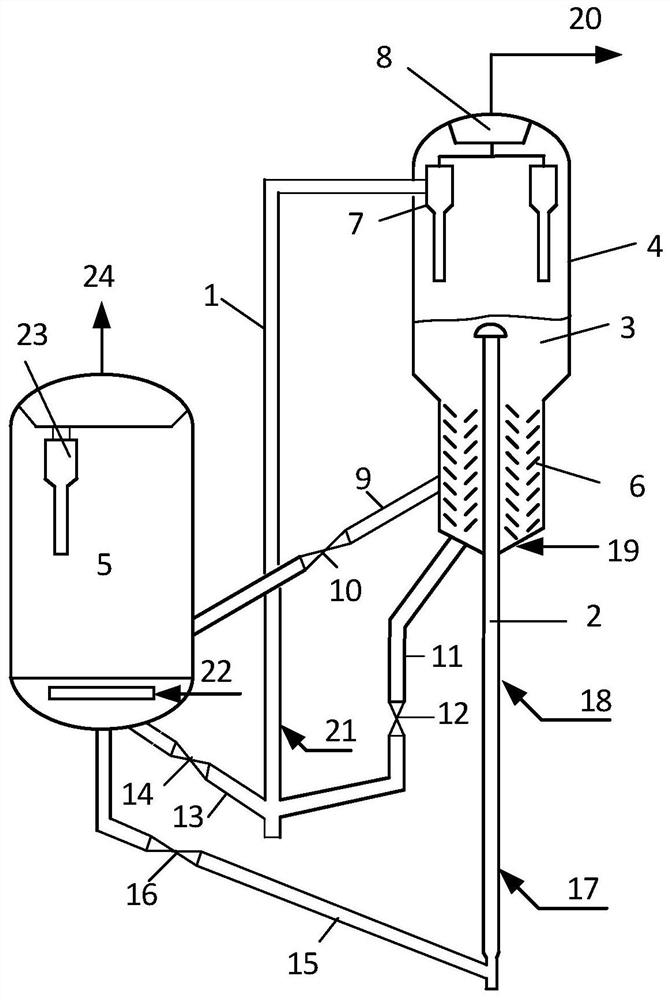A catalytic cracking method for producing light olefins and light aromatics
A technology for catalytic cracking and low-carbon olefins, applied in chemical instruments and methods, multi-stage series-connected refining and cracking process treatment, hydrocarbon cracking to produce hydrocarbons, etc. The effect of high yield, rich mesoporous structure and high yield
- Summary
- Abstract
- Description
- Claims
- Application Information
AI Technical Summary
Problems solved by technology
Method used
Image
Examples
preparation example Construction
[0069] The preparation method of catalytic cracking catalyst of the present invention comprises preparation and comprises Y-type molecular sieve, aperture is less than The microspherical composition of molecular sieves, natural minerals, and oxide binders, the present invention is called the first composition microspheres, and the first composition microspheres are modified; the first composition microspheres are modified; The ball modification process includes the following steps:
[0070] a. Put the microspheres of the first composition into an alkaline solution for treatment, filter and wash to obtain the microspheres of the first composition of alkali treatment;
[0071] b. Treat the alkali-treated first composition microspheres obtained in step a in a compound acid solution composed of fluosilicic acid, organic acid and inorganic acid, filter and wash, optionally exchange ammonium for sodium treatment, and optionally filter and optionally washed, optionally dried, to ob...
Embodiment approach
[0091] According to one embodiment of the present invention, when the method of the present invention is carried out in riser reactor, generally carry out as follows:
[0092] The regenerated catalyst (catalyst for catalytic cracking) enters the pre-lift section of the riser reactor and flows upward under the action of the pre-lift medium. The preheated raw oil and atomized steam are injected into the lower part of the riser reactor to contact the regenerated catalyst. The catalytic cracking reaction flows upward at the same time; the reacted oil and gas and the catalyst to be produced enter the fluidized bed reactor through the outlet of the riser reactor, and the reacted oil and gas react again, and the reacted stream enters the cyclone separator through the outlet of the riser reactor, and the separated reaction The oil and gas extraction device is further separated to obtain fractions such as methane, ethylene, propylene, C4 hydrocarbons, and pyrolysis gasoline rich in ligh...
Embodiment
[0113] according to figure 1 The process is tested, the feed oil is vacuum distillate oil, MMC-2 catalyst is used, and the test is carried out on a medium-sized device. The three reactors are all operated under normal pressure. The hydrocracking tail oil enters the riser 1, and the reaction temperature is 580 ℃, reaction time 2.0 seconds, the weight ratio of regenerated catalyst and raw catalyst mixture (wherein the raw catalyst accounts for 20% by weight of the catalyst mixture) to raw oil is 10, and the weight ratio of water vapor to raw oil is 0.25 to carry out the cracking reaction , the reaction oil gas and water vapor and the spent catalyst enter the cyclone separator from the reactor outlet.
[0114] Aromatic raffinate oil (saturated hydrocarbon content is 87% by weight) enters the bottom of the riser 2, and at a reaction temperature of 625°C and a reaction time of 1.8 seconds, the weight ratio of the regenerated catalyst to the feedstock oil is 15, and the weight ratio...
PUM
| Property | Measurement | Unit |
|---|---|---|
| specific surface area | aaaaa | aaaaa |
| research octane number | aaaaa | aaaaa |
| research octane number | aaaaa | aaaaa |
Abstract
Description
Claims
Application Information
 Login to View More
Login to View More - R&D Engineer
- R&D Manager
- IP Professional
- Industry Leading Data Capabilities
- Powerful AI technology
- Patent DNA Extraction
Browse by: Latest US Patents, China's latest patents, Technical Efficacy Thesaurus, Application Domain, Technology Topic, Popular Technical Reports.
© 2024 PatSnap. All rights reserved.Legal|Privacy policy|Modern Slavery Act Transparency Statement|Sitemap|About US| Contact US: help@patsnap.com








